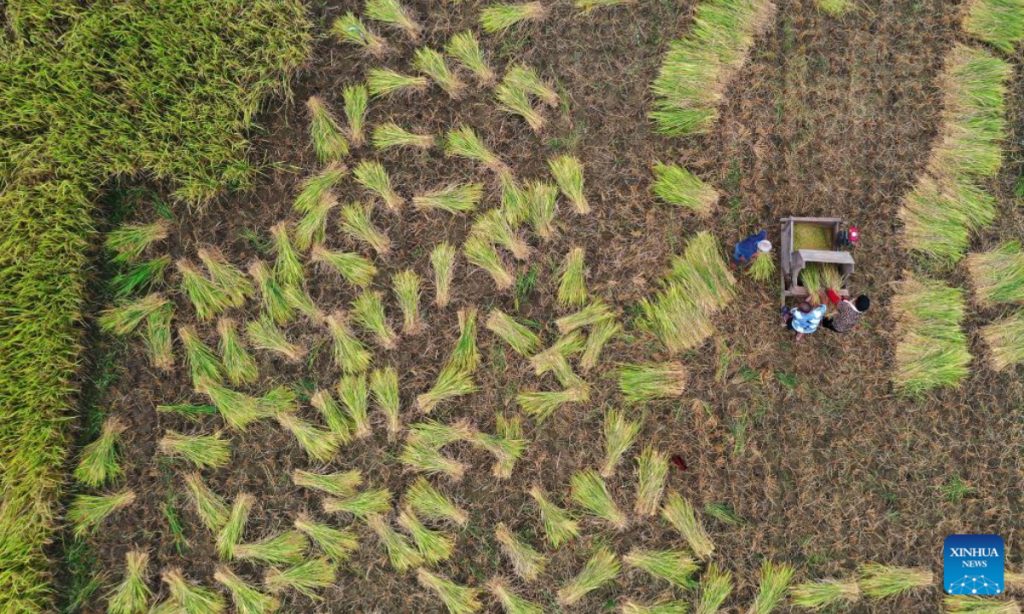Over 40% of autumn grains harvested in China; some report steady rise in output

Chinese farmers have harvested a total of 42.4 percent of autumn grain crops to date, with over half of the middle-season rice, over 40 percent of the corn and 40 percent of the soybeans having been reaped nationwide, data from the Ministry of Agriculture and Rural Affairs showed on Thursday.
Observers and industry insiders said on Friday that the figures show this year's autumn harvest is running on schedule, with some predicting a steady rise in grain output, which bodes well for the country's food security.
The autumn harvest is in full swing in major agricultural production bases across China. In particular, the reaping progress in southern China has surpassed 50 percent due to warmer weather, the Global Times learned.
In Southwest China's Sichuan Province, over 80 percent of the autumn grain crops have been reaped, according to media reports, while in Central China's Henan Province, farmers are accelerating work relatively late in the season due to unfavorable weather.
In Pahataikeli village in Kashi prefecture, Northwest China's Xinjiang Uygur Autonomous Region, harvesting of "seawater rice" began in early October. "Seawater rice" refers to rice grown in saline-alkali soil.
It is expected that the crop yield in the village will rise from 6,500 tons last year to over 7,000 tons this year, Li Duming, the village's Party chief, told the Global Times on Friday.
There are multiple reasons for the rise, including better climate conditions, improved soil conditions and better scientific management methods, Li said.
"We also employ more machinery including intelligent harvesters and drone sprayers, and the mechanization rate is estimated to have exceeded 90 percent this year," Li noted.
It's the fifth consecutive year that Pahataikeli village has planted rice with technological assistance from Shenzhen-based Zhong Nong Hai Dao. According to Li, China has over 1.5 billion mu (100 million hectares) of saline-alkali soil, of which one-third can be transformed into arable farmland.
The grain harvest in the village in Xinjiang, which is home to a vast area of saline-alkali soil, shows how China has been taking multi-pronged measures to shore up grain output in a bid to guarantee its food security.
A highlight from the ongoing autumn harvest is a steady rise in grain yield, thanks to the promotion of new agricultural technologies, rising machinery rates and government subsidies, observers said.
In Xinjiang's Ili Kazak autonomous prefecture, the corn output has set new records in terms of yield per mu, state broadcaster China Central Television reported on Thursday. In Jianping, Northeast China's Liaoning Province, the yield per mu of miscellaneous grain crops is up 10 percent, the report noted.
In August, the Chinese Ministry of Finance allocated 2.4 billion yuan ($334 million) worth of subsidies for fertilizers, pesticides and other agricultural sprays to improve the yields of autumn grains.
"It is highly likely that we could see a bumper autumn harvest this year based on the current progress. The influence of extreme weather conditions on harvesting is limited, and a stable grain price also helps to stabilize the planting area for autumn crops," Li Guoxiang, a research fellow at the Chinese Academy of Social Sciences, told the Global Times on Friday.
As the output of autumn grain accounts for more than 70 percent of the annual grain output, Li said a bumper autumn harvest bodes well for China's food security.
China aims to stabilize its annual grain output at over 650 billion kilograms, according to the country's 2023 Government Work Report.